



Let be \((O, \overrightarrow{i}, \overrightarrow{j}, \overrightarrow{k})\) an orthonormal coordinate system in space.
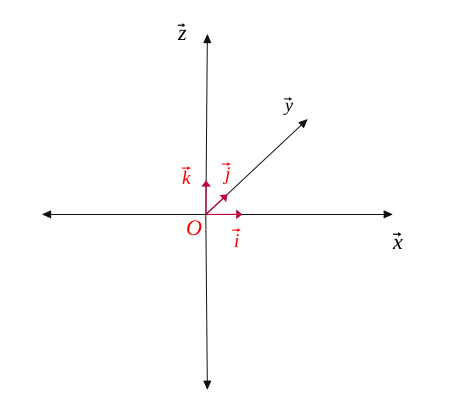
Parametric equation of a straight line
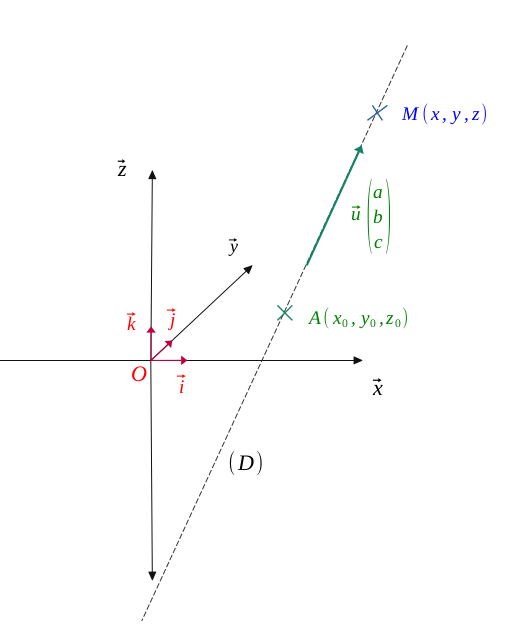
The parametric equation of a straight line \(\mathcal{D}\) in space, passing through a point \(A(x_0, y_0, z_0)\) and directed by a vector \(\vec{u}\begin{pmatrix} a\\ b \\c \end{pmatrix} \) (with \(a, b, c \) all three non-zero) is:
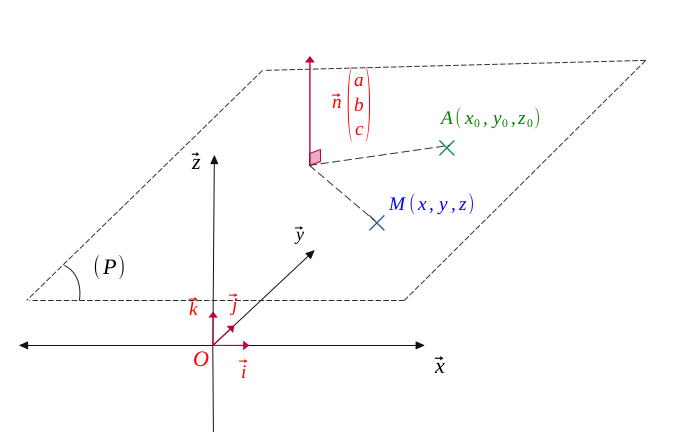
The equation of a place \((\mathcal{P})\) in space, passing through a point \(A(x_0, y_0, z_0)\) and orthogonal to a vector \(\vec{n}\begin{pmatrix} a\\ b \\c \end{pmatrix}\) (with \(a, b, c \) all three non-zero) is:
Distance from a point to a plane
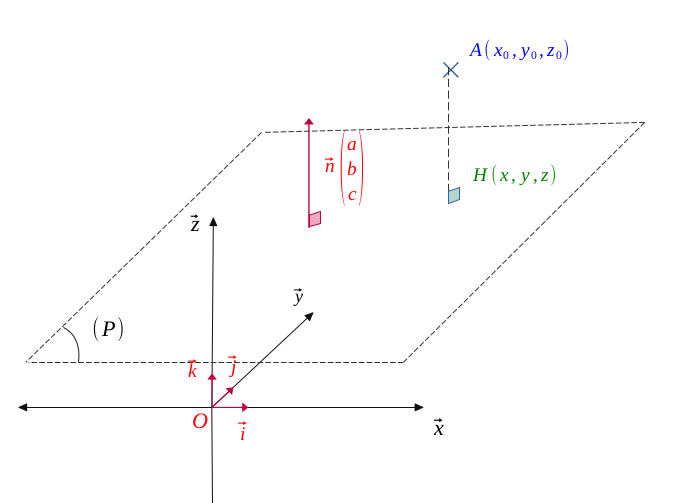
Let \(\mathcal{P}\) be a plane orthogonal to a vector \(\vec{n}\begin{pmatrix} a\\ b \\c \end{pmatrix}\) (with \(a, b, c \) all three non-zero), having as equation:
The distance from a point \(A(x_0, y_0, z_0)\) in relation to this plane \((\mathcal{P})\) orthogonally projecting on this plane at point \(H(x, y, z)\) is worth:
Projection of a sum of vectors upon a plane
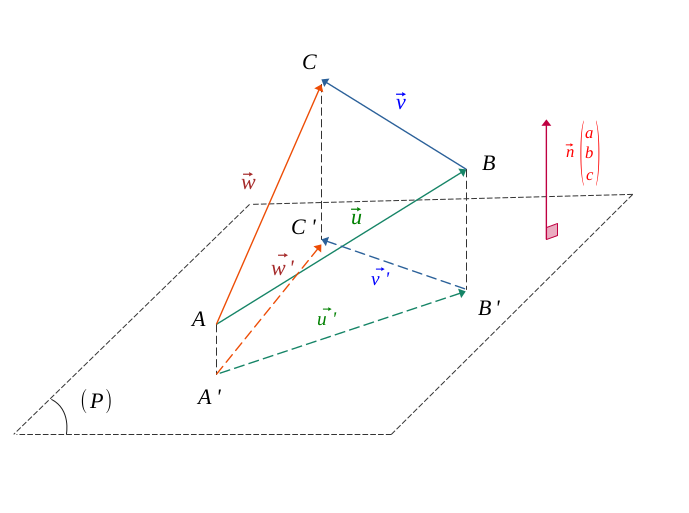
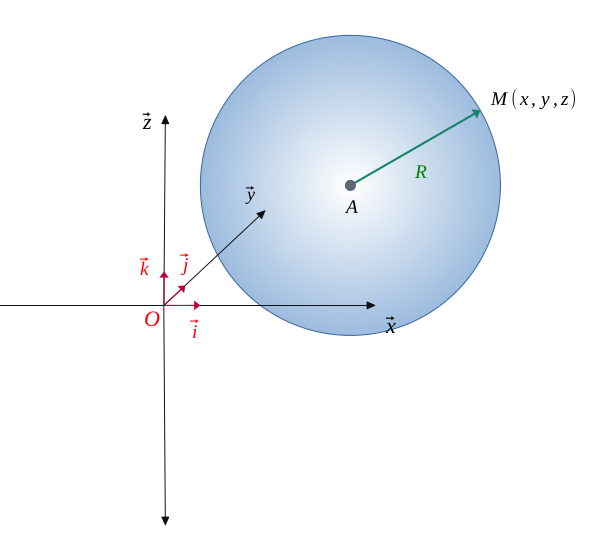
The sphere \((\mathcal{S})\) having a radius \(R\) and centered at point \(A(x_0, y_0, z_0)\) has for equation in space:

The cylinder\((\mathcal{C})\) having a radius \(r\) and centered at point \(A(x_0, y_0, z_0)\) has for equation in space:
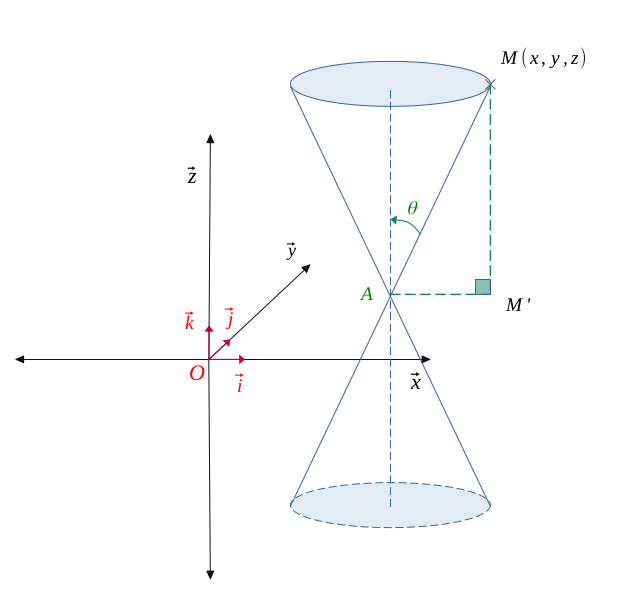
The cone \((\mathcal{C})\) having a half-angle \( \theta\), and centered at point \(A(x_0, y_0, z_0)\) has for equation in space:
From cartesian to spherical coordinates
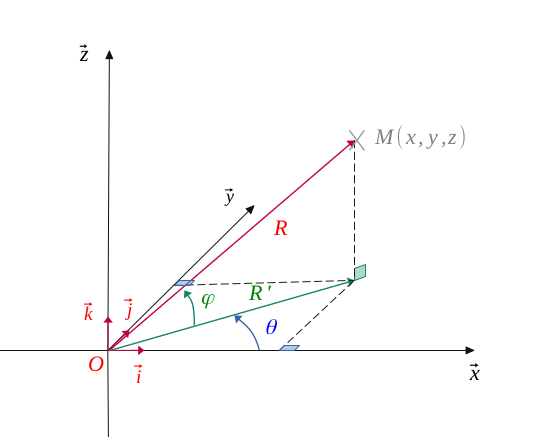
$$ \Biggl \{ \begin{gather*} x = R \ cos(\varphi) \ cos(\theta) \\ y = R \ cos(\varphi) \ sin(\theta) \\ z = R \ sin(\varphi) \end{gather*} \qquad (\theta : longitude- \varphi : latitude) $$
$$with \enspace \left \{ \begin{gather*} R =\sqrt{x^2 +y^2 +z^2 } \\ \theta = arctan \left( \frac{y}{x} \right) \\ \varphi = arcsin \left( \frac{z}{R} \right) \end{gather*} \right \}$$
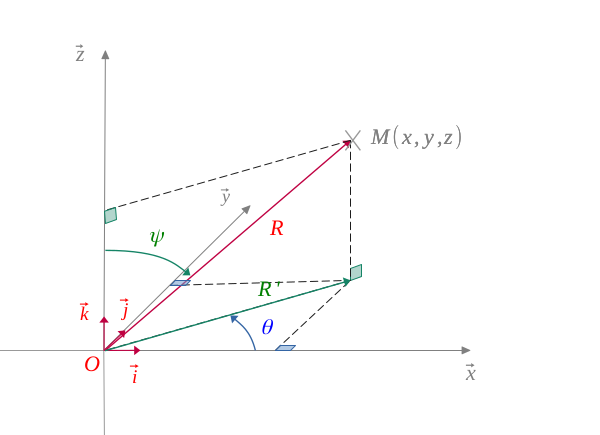
$$ \Biggl \{ \begin{gather*} x = R \ sin(\psi) \ cos(\theta) \\ y = R \ sin(\psi) \ sin(\theta) \\ z = R \ cos(\psi) \end{gather*} \qquad (\theta : longitude- \psi : colatitude) $$
$$with \enspace \left \{ \begin{gather*} R =\sqrt{x^2 +y^2 +z^2 } \\ \theta = arctan \left( \frac{y}{x} \right) \\ \psi = arccos \left( \frac{z}{R} \right) \end{gather*} \right \}$$
Let \((\mathcal{D})\) be a straight line in space, passing through a point \(A(x_0, y_0, z_0)\) and directed by a vector \(\vec{u}\begin{pmatrix} a\\ b \\c \end{pmatrix} \) (with \((a, b, c) \in \hspace{0.05em} \mathbb{R}^3 \) three real numbers which are non-zero simultaneously).

As \(M \in \mathcal{D}\), so the vectors \(\vec{u}\) and \(\overrightarrow{AM}\) are collinear. Thus:
The parametric equation of a straight line \(\mathcal{D}\) in space, passing through a point \(A(x_0, y_0, z_0)\) and directed by a vector \(\vec{u}\begin{pmatrix} a\\ b \\c \end{pmatrix} \) (with \((a, b, c) \in \hspace{0.05em} \mathbb{R}^3 \) three real numbers which are non-zero simultaneously) is:
The parameter \(t\) is a free parameter that can take any value.
In fact, the line \((\mathcal{D})\) extending to infinity, we obtain a formation of this latter by varying \(t\), leading to the intersection of three planes corresponding respectively to the three equations; which forms a series of points in space.
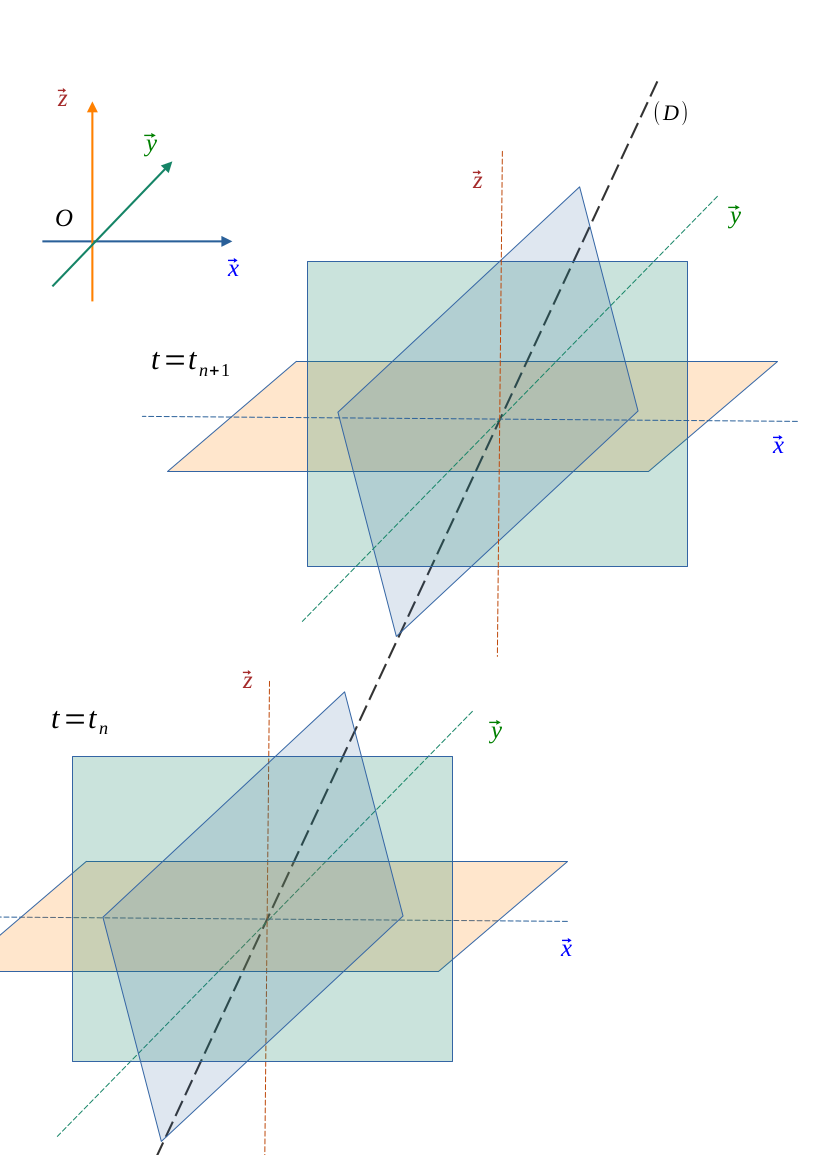
Let \((\mathcal{P})\) be a plane in space, passing through a point \(A(x_0, y_0, z_0)\) and orthogonal to a vector \(\vec{n}\begin{pmatrix} a\\ b \\c \end{pmatrix}\) (with \((a, b, c) \in \hspace{0.05em} \mathbb{R}^3 \) three real numbers which are non-zero simultaneously).

So, any point \(M\bigl[x, y, z \bigr]\) belonging to this plane is orthogonal to \(\vec{n}\).
Two orthogonal vectors have their scalar product worthing zero.
The equation of a place \((\mathcal{P})\) in space, passing through a point \(A(x_0, y_0, z_0)\) and orthogonal to a vector \(\vec{n}\begin{pmatrix} a\\ b \\c \end{pmatrix}\) is:
Let \((\mathcal{P})\) be a plane in space, orthogonal to a vector \(\vec{n}\begin{pmatrix} a\\ b \\c \end{pmatrix}\)(with \((a, b, c) \in \hspace{0.05em} \mathbb{R}^3 \) three real numbers which are non-zero simultaneously).
Let \(A(x_0, y_0, z_0)\) be a point orthogonally projecting on \((\mathcal{P})\) at point \(H(x, y, z)\).

We are trying to estimate the distance \(AH\), shortest distance from the point \(A\) to the plane \((\mathcal{P})\).
By the definition of the scalar product, we do have:
On the other hand, with the calculation of the scalar product by the coordinates product, we do have:
Given that \((1)\) and \((2)\) are equal, being the smae scalar product, we now have:
Calculant une distance, on peut passer en valeur absolue :
The distance from a point \(A(x_0, y_0, z_0)\) in relation to this plane \((\mathcal{P})\) orthogonally projecting on this plane at point \(H(x, y, z)\) is worth:
In this part, the term projection will always means orhtogonal projection.
Let \((\mathcal{P})\) be a plane having as normal vector \(\vec{n}\begin{pmatrix} a\\ b \\c \end{pmatrix}\), and two non-null vectors being non-collinear to this plane, \(\vec{u}\begin{pmatrix} x_1\\ y_1 \\z_1 \end{pmatrix}\) and \(\vec{v}\begin{pmatrix} x_2\\ y_2 \\z_2\end{pmatrix}\).
Let us call \(\vec{u'}\) and \(\vec{v'}\) the respective projections of the two vectors \(\vec{u}\) and \(\vec{v}\) upon this plane.
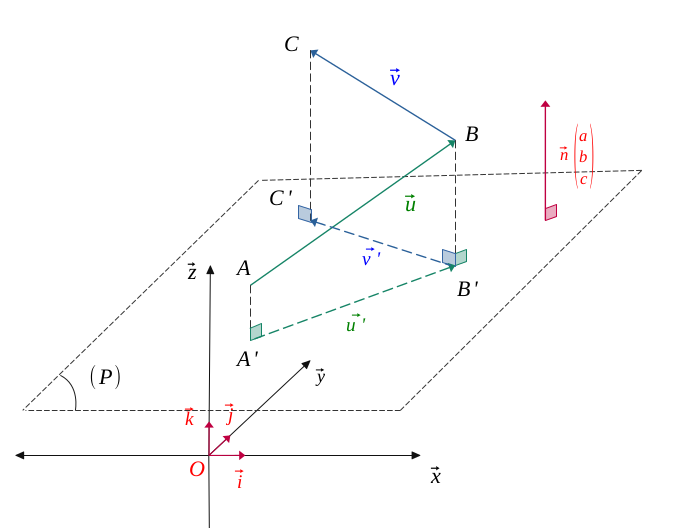
For the sake of simplicity, we placed the points \(A, B, C\) as well as their respective projection \(A', B', C'\).
Now, let \(\vec{w} = \vec{u} + \vec{v}\), the sum of vectors \(\vec{u}\) and \(\vec{v}\), and the vector \(\vec{w'}\) being the projection of \( \vec{w}\) on this plane.
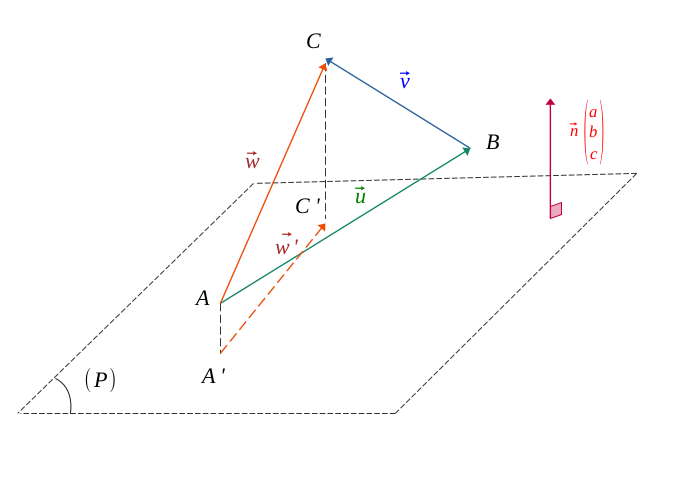
In the case of the initial points \(A, B, C\) and those of their respective projection \(A', B', C'\), the Chasles relation applied:

$$ \Biggl \{ \begin{gather*} \vec{u} + \vec{v} = \vec{w} \\ \vec{u}' + \vec{v}' = \ \vec{w}' \end{gather*} $$
Therefore,
Let \((\mathcal{S})\) be a sphere having a radius \(R\) and centered at point \(A(x_0, y_0, z_0)\).

On this sphere, every point every point \(M\bigl[x, y, z \bigr]\) is equidistant from the point \(A\), which is worth the length of the radius \(R\).
We know that using the the Pythagorean theorem, that the distance \( AB\) in a three-dimensional space is worth:
So,
The sphere \((\mathcal{S})\) of radius \(R\) and centered at point \(A(x_0, y_0, z_0)\) has for equation in space:
Let \((\mathcal{C})\) be a vertical cylinder of radius \(r\) and centered at point \(A(x_0, y_0, z_0)\).

In the plane \((O, \overrightarrow{i}, \overrightarrow{j})\), the cylinder describes a circle.
We know that using the the Pythagorean theorem, that the distance \( AB\) in a plane is worth:
We then have,
The vertical axis \(z\) can take any value, so it is a free variable.
The cylinder \((\mathcal{C})\) having a radius \(r\) and centered at point \(A(x_0, y_0, z_0)\) has for equation in space:
Let \((\mathcal{C})\) a vertical cone have as half-angle \( \theta\), and centered at point \(A(x_0, y_0, z_0)\).

In the figure below, we can see that:
The cone \((\mathcal{C})\) have as half-angle \( \theta\), and centered at point \(A(x_0, y_0, z_0)\) \(A(x_0, y_0, z_0)\) has for equation in space:
In some cases, it can be useful to use spherical coordinates (in two dimensions : polar coordinates), especially when working with spheres.
In a usual orthonormal reference frame in space \((O, \overrightarrow{i}, \overrightarrow{j}, \overrightarrow{k})\), we represented a point \(M\bigl[x, y, z \bigr]\).

Let \(R\) representing the distance from this point to the origin and \(R'\) its projection on the horizontal plane \((O, \overrightarrow{i}, \overrightarrow{j})\).
Likewise, we called \(\theta\) the angle formed by the abscissa axis \((O, \overrightarrow{i})\) and \(R'\), and also \(\varphi\) the angle formed \(R'\) and \(R\).
$$ \Biggl \{ \begin{gather*} \theta = (\overrightarrow{Ox}, \overrightarrow{R'}) \\ \varphi= (\overrightarrow{R'}, \overrightarrow{R})\end{gather*} $$
In the following figure, we have represented the point \(M'\), projection of point \(M\) on the horizontal plane \((O, \overrightarrow{i}, \overrightarrow{j})\).

With the classic trigonometry rules, we easily see that:
$$ \Biggl \{ \begin{gather*} z = R \ sin(\varphi) \\ R' = R \ cos(\varphi) \end{gather*} $$
Now, working with a front view of the horizontal plane \((O, \overrightarrow{i}, \overrightarrow{j})\), we can calculate the coordinates corresponding to \(x\) and \(y\).
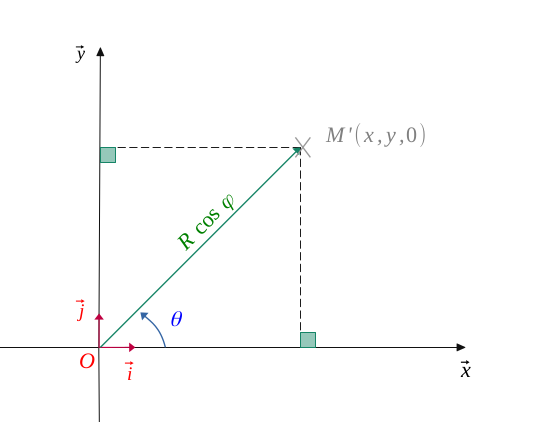
We do have :
$$ \Biggl \{ \begin{gather*} x = R \ cos(\varphi) \ cos(\theta) \\ y = R \ cos(\varphi) \ sin(\theta) \end{gather*} $$
Finally, the distance \(R\) is easily calculated from cartesian coordinates \((x, y, z)\):
As well, we obtain both angles \(\theta\) and \(\varphi\) by:
$$ \Biggl \{ \begin{gather*} \theta = arctan \left( \frac{y}{x} \right) \\ \varphi = arcsin \left( \frac{z}{R} \right) \end{gather*} $$
So,
$$ \Biggl \{ \begin{gather*} x = R \ cos(\varphi) \ cos(\theta) \\ y = R \ cos(\varphi) \ sin(\theta) \\ z = R \ sin(\varphi) \end{gather*} \qquad (\theta : longitude- \varphi : latitude) $$
$$with \enspace \left \{ \begin{gather*} R =\sqrt{x^2 +y^2 +z^2 } \\ \theta = arctan \left( \frac{y}{x} \right) \\ \varphi = arcsin \left( \frac{z}{R} \right) \end{gather*} \right \}$$
here is another way to represent spherical coordinates; we can use colatitude instead of latitude.
We then have a new angle \(\psi\) which starts from the vertical axis \(\overrightarrow{Oz}\) towards \(R\) in the antitrigonometric direction.

$$ \Biggl \{ \begin{gather*} \theta = (\overrightarrow{Ox}, \overrightarrow{R'}) \\ \varphi= (\overrightarrow{Oz}, \overrightarrow{R})\end{gather*} $$
Which gives us, applying the same reasoning:
$$ \Biggl \{ \begin{gather*} x = R \ sin(\psi) \ cos(\theta) \\ y = R \ sin(\psi) \ sin(\theta) \\ z = R \ cos(\psi) \end{gather*} \qquad (\theta : longitude- \psi : colatitude) $$
$$with \enspace \left \{ \begin{gather*} R =\sqrt{x^2 +y^2 +z^2 } \\ \theta = arctan \left( \frac{y}{x} \right) \\ \psi = arccos \left( \frac{z}{R} \right) \end{gather*} \right \}$$
Let us find the intersection \((\mathcal{P} \cap \mathcal{P}') \) between the two planes \((\mathcal{P}) \) and \((\mathcal{P}') \).
$$ (\mathcal{S}) \ \Biggl \{ \begin{gather*} \ \ 3x \ - \ y \ + z \hspace{1.8em}= 0 \qquad (\mathcal{P}) \\ -2x +2y + z + 1 = 0 \qquad (\mathcal{P}') \end{gather*} $$
We scale the system \((\mathcal{S})\) performing the linear combination \( 2(\mathcal{P}) \) + \( 3(\mathcal{P}') \).
$$ (\mathcal{S}) \ \Biggl \{ \begin{gather*} 3x - y \ + z = 0 \hspace{5em} (\mathcal{P}) \\ \ \ \ \ 4y +5 z = -3 \qquad \qquad (2(\mathcal{P}) + 3(\mathcal{P}') ) \end{gather*} $$
The system is of the rank \(2\), then the intersection is a straight line which we will note \( (\mathcal{D})\). Moreover, the parameter \( z \) is a free variable and:
So, we solve the system by going backwards and we find:
$$ \left \{ \begin{gather*} x = \frac{-3z-1}{4} \\ y = \frac{-5z-3}{4} \\ z= z \end{gather*} \right \} $$
We choose as value \( z = 0 \) to fix a point on the line \( (\mathcal{D})\). So \( A\left(-\frac{1}{4},-\frac{3}{4}, 0 \right) \in \mathcal{D}\).
Furthermore, we see that the vector \(\vec{u}\begin{pmatrix} -\frac{3}{4} \\ - \frac{5}{4} \\ \hspace{1em} 1 \end{pmatrix}\) leads the straight line \( (\mathcal{D})\), then the latter has the equation:
So,
Let us find the intersection \((\mathcal{D} \cap \mathcal{P}) \) between a line \((\mathcal{D}) \) and a plane \((\mathcal{P}) \).
We inject the coordinates of \((\mathcal{D}) \) in those of \((\mathcal{P}) \), and we solve \((L) \) :
As \(t \) is unique, there is a point of intersection, which we will note \(A\).
We thus determine this point using the parametric equation of the line \((\mathcal{D}) \).
Then this point of intersection is:
Let us find the intersection \((\mathcal{D} \cap \mathcal{D}') \) between two lines \((\mathcal{D}) \) and \((\mathcal{D}') \).
We do the following system:
$$ (\mathcal{D} \cap \mathcal{D}') \ \Longleftrightarrow \Biggl \{ \begin{gather*} 2t-1 = s+1 \\ -t-2 = 3s-1\\ t +2 = 2s+1\end{gather*} $$
$$ (\mathcal{D} \cap \mathcal{D}') \ \Longleftrightarrow \ \Biggl \{ \begin{gather*} 2t-s = 5 \ \ \qquad (L_1) \\ -t-3s = 1 \qquad (L_2) \\ t-2s = -1 \qquad (L_3) \end{gather*} $$
We first solve the first two equations. We carry out \( (L_1 + 2 L_2)\):
This solution is not suitable for the third one \( (L_3)\) because:
So, as there is no pair \( (t, s) \in \hspace{0.05em} \mathbb{R}^2\) which are suitable for the two parametric equations of the two lines \((\mathcal{D}) \) and \((\mathcal{D}') \), they have no point of intersection.
Let us find the intersection \((\mathcal{P} \cap \mathcal{S}) \) between a plane\((\mathcal{P}) \) and a sphere \((\mathcal{S}) \).
We now inject \((\mathcal{P}) \) into \((\mathcal{S}) \):
So, we get an equation for the coordinates \((x,y) \in \hspace{0.05em} \mathbb{R}^2 \). On the other hand, it is the equation of a cone of radius \(R = \frac{\sqrt{3}}{2}\), so it is then necessary to keep the equation of the plane \((\mathcal{P}) \) to fix the cone and therefore obtain a circle.
So, the intersection between \((\mathcal{P}) \) and \((\mathcal{S}) \) is modelled by the double equation:
$$ (\mathcal{P} \cap \mathcal{S}) \ \Longleftrightarrow \ \Biggl \{ \begin{gather*} x^2 + y^2 = \frac{3}{4} \\ z = \frac{1}{2} \end{gather*} $$
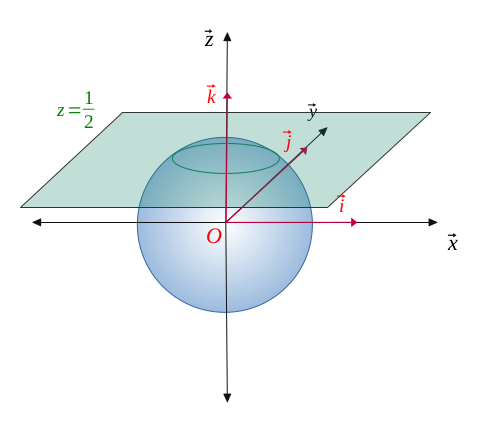
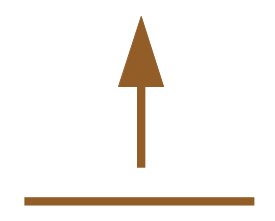 Go to the top of the page
Go to the top of the page